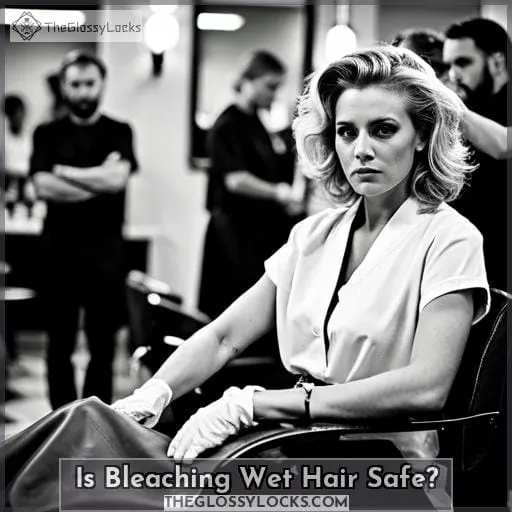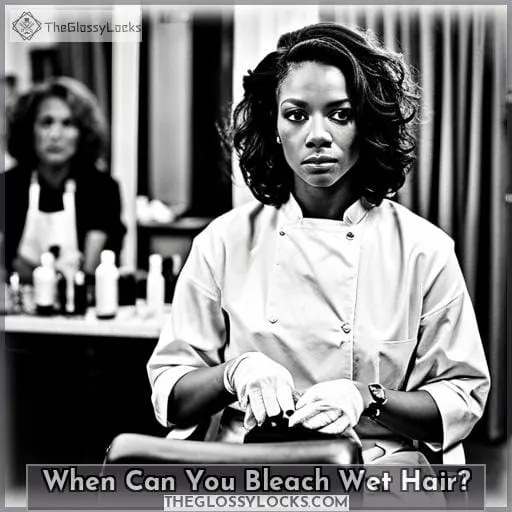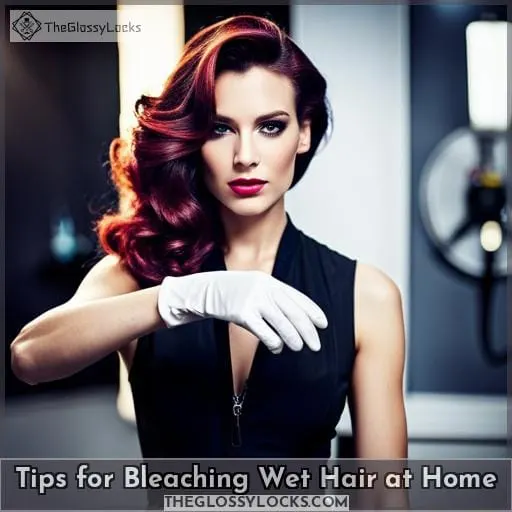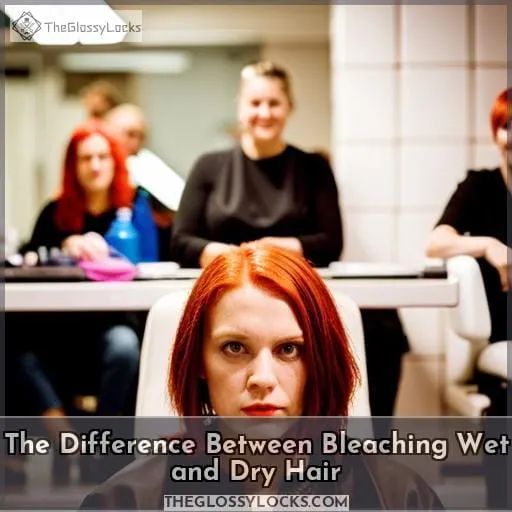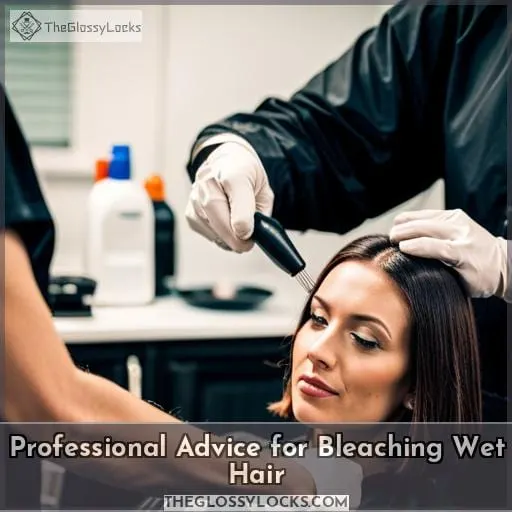This site is supported by our readers. We may earn a commission, at no cost to you, if you purchase through links.
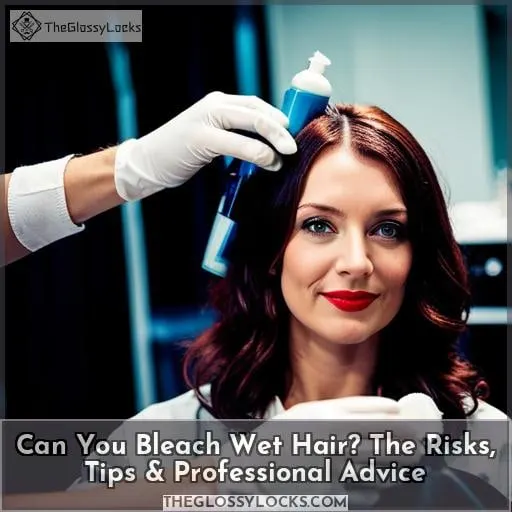 Are you considering bleaching your hair? Whether you’re aiming for a more dramatic change or just looking to brighten up the ends, understanding when and how to bleach wet hair is key. While it may seem counterintuitive, there can be benefits of bleaching damp hair—but also risks that come with doing so.
Are you considering bleaching your hair? Whether you’re aiming for a more dramatic change or just looking to brighten up the ends, understanding when and how to bleach wet hair is key. While it may seem counterintuitive, there can be benefits of bleaching damp hair—but also risks that come with doing so.
Read on for tips on how to safely bleach wet hair at home as well as professional advice from stylists and colorists about achieving the look you want without sacrificing your locks in the process.
Table Of Contents
Key Takeaways
- Bleaching wet hair can have benefits such as faster processing and subtle lightening.
- Risks of bleaching damp hair include increased fragility, potential damage, stripping away natural oils, split ends, and permanent hair loss.
- Longer exposure times during wet bleaching can lead to scalp irritation.
- It is important to take precautions and follow a post-bleaching routine for healthy colored hair.
Is Bleaching Wet Hair Safe?
Considering bleaching wet hair? You may be wary of the risks associated with this process. Before taking the plunge, it’s important to consider all factors involved in both professional and at-home bleaching treatments.
The Risks of Bleaching Wet Hair
Although there may be advantages to bleaching damp locks, such as faster processing and subtle lightening, the fragility of wet hair can increase the risk of damage during this process. Wet bleach can strip away natural oils from the scalp and ends, potentially leading to split ends or even permanent hair loss.
Over-bleaching on damp locks also increases the likelihood of scalp irritation due to longer exposure times. It is essential that you take precautions when considering wet bleaching by following a strict post-bleaching routine for healthy colored hair and consulting with professionals prior to attempting any at-home treatments.
Factors to Consider Before Bleaching Wet Hair
Before bleaching wet hair, it’s important to consider the potential risks and rewards of this process. Studies have shown that up to 80% of people who bleach their hair experience some degree of damage.
The protective barrier in damp strands can be compromised during a bleaching process, making them more vulnerable to breakage or other forms of damage.
Additionally, colorists may opt for a longer exposure time when working on damp locks due to quicker processing results and lighter tints. On the other hand, dry hair tends towards stronger color change with shorter exposure times.
Ultimately, one should weigh the pros and cons before deciding if wet balayage is right for them. It is also advisable to consult an experienced professional about any concerns regarding safety or desired outcomes from the treatment.
Professional Vs. At-Home Bleaching
When considering a bleaching process, it’s important to assess the best approach for your individual needs and determine whether professional or at-home treatments are the right fit.
Professional consultations help identify potential risks associated with wet hair bleaching and provide tailored advice on bleach product selection. DIY bleaching can be done with caution, but it may not optimize hair health due to a lack of experience and specific instructions.
Bleaching dry hair allows for more control over processing time while minimizing damage from heat exposure. However, if opting for the wet balayage technique, there is less risk of scalp irritation and softer results overall.
Ultimately, seeking expert guidance reduces the likelihood of permanent damage regardless of the chosen method—wet or dry—and helps maintain healthy colored locks long after treatment has been completed!
When Can You Bleach Wet Hair?
You may have heard of wet bleaching as a new hair trend, but did you know that it can be used to lighten hair faster and achieve subtle color changes? Wet bleaching is the perfect technique for brightening up ends while avoiding damage.
It’s an ideal choice when looking to make slight adjustments in tone or radiance without over-processing your locks.
Lightening Hair Faster With Wet Bleaching
Ready to lighten up your locks? Wet bleaching can provide faster, softer results for a subtle color change. To minimize damage, leave the bleach on wet hair for no more than 15 minutes and always seek professional guidance when attempting this technique.
With safe techniques like quick rinses or water spritzes, you can achieve brightening ends with the wet balayage method – perfect if you’re looking to add dimension without a drastic difference in tone!
A key benefit of bleaching damp hair is its faster application time compared to dry hair; however, be aware that longer exposure may cause greater damage. For best results and protection against harm, opt for reliable products from experienced colorists and follow all instructions closely before taking any risks with lightening methods yourself.
Achieving Subtle Color Changes With Wet Bleaching
With wet bleaching, you can achieve subtle color changes that are tailored to your preference. To get the desired look without too much damage, opt for a lighter shade of blonde with a low-volume developer and professional lightening products like WELLA Color Charm Powder Hair Lightener.
You may also use Luseta Blonde Gray Shampoo Conditioner to maintain glossiness and restore vibrancy after wet balayage or full head lightening treatments. Wet bleaching is an ideal option when aiming for softer results without damaging fragile ends of damp hair.
Brightening Ends With Wet Bleaching
For a brightening effect, you can use the wet balayage technique to add subtle highlights to your ends. This method of bleaching combines moisture retention with color correction for a look that’s both modern and gentle on hair.
It allows bleach to penetrate the cuticle more quickly than dry bleaching, resulting in faster lightening without over-processing.
Wet balayage also helps retain natural oils, which protect the scalp from irritation and damage during processing time. For best results, leave the bleach on damp hair for up to 30 minutes, depending on the desired shade.
Tips for Bleaching Wet Hair at Home
Aspiring to bleach your wet hair at home? Before you start, there are a few things you should consider. To ensure the best results, avoid washing your hair before bleaching and take time to prepare damp strands for safe processing.
Once done, maintain a strict post-bleaching hair care routine that includes quality shampoos and conditioners to protect newly colored tresses from further damage.
Avoiding Washing Hair Before Bleaching
To ensure the best bleaching results, avoid washing your locks in advance. A buildup of natural oils can protect your scalp from harsh chemicals and risks associated with wet bleaching.
Consult a stylist for expert advice on how to prepare hair prior to dyeing or lightening. If you’re considering an at-home bleach kit, use caution as this process can potentially harm damp hair due to its fragility when wet.
Refrain from using hot styling tools a week before bleaching and keep your tresses clean 24 hours before applying any bleach product.
Preparing Damp Hair for Bleaching
Before you even consider bleaching your damp hair, it’s important to take a few preparatory steps. Coat your hair with moisture protection like L’Oréal Paris Feria Hyper Platinum Advanced Lightening System Bleach beforehand.
Use color brighteners such as the Luseta Blonde Gray Shampoo Conditioner for improved vibrancy. When applying bleach, make sure to avoid scalp irritability or discomfort by keeping the product away from skin contact.
For best results when wet bleaching techniques are used on damp hair, limit exposure time to 15-30 minutes. Afterward, maintain healthy strands with specialized products tailored for colored locks.
Maintaining a Post-Bleaching Hair Care Routine
Once you’ve bleached your hair, it’s essential to commit to a dedicated hair care routine in order to keep it healthy and vibrant. Consistent use of high-quality shampoos and conditioners designed for colored hair will help maintain color vibrancy while replenishing moisture lost during bleaching.
To ensure maximum effectiveness, consult with a professional stylist or chemical engineer beforehand so they can provide tailored after-care advice for dyed hair. Protecting strands from heat styling tools is important too; opt for air drying instead whenever possible.
Lastly, regular deep conditioning treatments are recommended as an extra layer of protection against the brittle texture and split ends caused by the effects of bleach on wet or dry locks!
The Difference Between Bleaching Wet and Dry Hair
When it comes to bleaching hair, there is a distinct difference between wet and dry methods. Both have their pros and cons that should be considered before attempting either one at home. Wet bleaching can result in faster lightening but may cause more damage due to the open cuticle of damp hair, while dry bleach will give a longer-lasting color change, with less risk of harm from its slower processing time.
Pros and Cons of Bleaching Wet Hair
If you’re considering taking the plunge and bleaching your hair, it’s important to weigh the pros and cons of wet vs. dry bleaching first. Wet bleach has several benefits, including faster lightening, which locks in moisture for a softer result that reduces dye absorption.
This method is best for subtle color changes or brightening ends with balayage techniques.
However, wet hair can be more vulnerable to damage during this process, so caution should be taken when attempting at-home treatments without professional consultation from a skilled colorist who understands industrial chemical processes associated with platinum tinting or other complex coloring tasks like ombre styles.
When done properly under expert supervision, bleached damp hair may yield long-lasting results by helping protect natural oils while delivering brighter colors than dry methods alone. This is due to an open cuticle allowing deeper penetration of bleach molecules into each strand for better decomposition of melanin pigments, releasing lighter shades.
Ultimately, scheduling an appointment with a salon ensures optimal safety as well as beautiful vibrant hues achieved through tailored guidance on proper procedures specific to individual needs. This includes pre-bleach maintenance routines involving avoidance of heat styling tools and the use of quality shampoos like Luseta Purple Shampoo Conditioner before committing to permanently lighten strands.
Pros and Cons of Bleaching Dry Hair
Comparing the two, bleaching dry hair may provide more vibrant color results, but it also carries a higher risk of damage. Bleaching techniques such as balayage and highlights are popular for creating modern trends in hair coloring.
However, scalp protection should be taken into account when lightening your locks with bleach products like Luseta Purple Shampoo.
Dry hair is vulnerable to heat damage during this process, so avoid using hot styling tools before bleaching and consider professional advice if you’re new to dyeing your tresses. Chlorinated pools can alter coloration, while excess sun exposure without adequate protection can cause further harm.
Industrial chemicals used in at-home treatments pose an added risk and require extra care if attempted by inexperienced hands – proceed with caution!
Professional Advice for Bleaching Wet Hair
When bleaching your hair, it is important to seek professional advice from a hairstylist or colorist. Consider the condition of your hair and follow the instructions provided for safe bleaching. With their help, you can ensure that you achieve the desired results without damaging your hair in any way.
Consulting a Hair Stylist or Colorist
Consulting a professional hair stylist or colorist is the best way to ensure the safety of your wet-bleaching treatment and achieve desirable results. For example, if you’re looking to brighten your blonde ends with the balayage technique, a skilled colorist can provide expert advice on how to proceed.
With their expertise in hair consultation and bleaching guidance, they will recommend products based on your desired look. They may also suggest opting out of heat treatments both before and after the treatment to minimize damage.
By following their recommendations, you can have a beautiful sun-kissed mane without compromising the health of your hair.
Whether you plan to bleach your wet hair at home or at a salon, consulting a trusted hairstylist or colorist should always be your top priority. They have the knowledge and experience to guide you through the process and ensure that your hair remains healthy and vibrant.
So, before you embark on any hair bleaching journey, make sure to seek professional advice to achieve the best results.
Considering the Condition of Your Hair
Before bleaching, it is important to assess the condition of your hair. Hair health and skin elasticity are key factors in achieving a successful color transformation without risking too much damage. Consider using Luseta purple shampoo and conditioner to strengthen damaged strands before wet bleaching, as well as anti-aging products to reduce fine lines and wrinkles that could be made more prominent by the process.
Bleaching may decompose melanin pigments, resulting in irreversible changes if not done properly or with caution.
Following Proper Instructions for Safe Bleaching
Following the manufacturer’s directions is key for a safe bleaching experience. When choosing to bleach wet hair, make sure you’re using a reputable product and that your scalp is well-protected. Proper application techniques are essential to avoid irritation and achieve the desired results.
For a pure blonde base, leave the bleach on for only 15 minutes, or up to 30 minutes for a platinum tint. It’s always a good idea to consult an expert colorist with Enzo’s experience before starting any process involving bleaching wet hair.
Enzo, a chemical engineer from the University at Buffalo and Columbia University, can provide tailored care advice.
Conclusion
Bleaching wet hair can be a risky endeavor, and although it can be done in certain cases, it’s generally not recommended. It’s important to remember that bleached hair is more vulnerable to damage, and the longer bleach is left on the hair, the more damage it can cause.
When considering bleaching wet hair, it’s best to consult a professional colorist to determine the safest and most effective approach. According to the American Academy of Dermatology, up to 75% of people who bleach their hair are likely to experience some form of hair damage, so it’s important to be extra cautious when bleaching wet hair.
Taking the right precautions, such as avoiding hot styling tools and maintaining a strict post-bleaching hair care routine, can help keep your hair healthy and looking its best.

